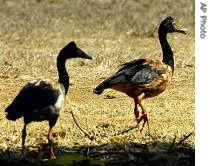2006年VOA标准英语-Australia Tests Bird Flu Defenses(在线收听)
By Phil Mercer
Sydney
19 October 2006
One-thousand people in Australia have conducted a four-day bird flu exercise that simulated the arrival of a planeload of flu-stricken passengers at Brisbane's international airport. The drill included customs officers, the police, and health workers.
----
 Magpie geese rest in a mango tree plantation in Darwin, Australia |
||
The four-day simulation, called Exercise Cumpston after a famous scientist, tested Australia's readiness for a bird flu outbreak.
It began at the international airport in the east coast city of Brisbane. One-hundred-50 passengers, played by actors, arrived on board a flight from the fictitious Asian country of Acamar, which had reported an outbreak of avian influenza.
A series of drills tested the readiness of customs officers, who separated the "sick" passengers at the airport, and emergency services and health workers at two city hospitals designated to treat the disease. A mock emergency cabinet meeting was held in the federal capital, Canberra.
Australia's federal health minister, Tony Abbot, says the test showed that the country is prepared.
"Exercise Cumpston is the largest ever health simulation exercise undertaken in Australia," said Abbot. "I think what we have seen today demonstrates just how thorough the preparation for a potential bird flu outbreak has been."
Experts believe that if bird flu reaches Australia, it will almost certainly be spread by air travel rather than by migrating birds.
The drill was held in the northeastern state of Queensland because officials there believe the region, with its three international airports, is one of the most vulnerable in the country to the disease.
Meanwhile Australian health authorities approved trials for a new bird flu vaccine.
The H5N1 virus first appeared in Hong Kong in 1997, where 18 people were infected and six died. The disease reappeared in Vietnam and China in 2003, and has since killed more than 150 people, mostly in Southeast Asia.
Almost all human cases have come from people handling infected poultry. But scientists fear the virus could mutate into a form that can pass rapidly between humans, which could lead to a global pandemic putting millions of people at risk.
The Australian government has spent more than $450 million preparing for such an outbreak, and has built up one of the world's largest stockpiles of anti-viral drugs.